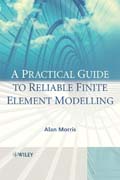
A practical guide to reliable finite element modelling: how to do safe analyses using the finite element method
Morris, Alan
Many books have been written about the finite element method; little however has been written about procedures that assist a practicing engineer in undertaking an analysis in such a way that errors and uncertainties can be controlled. In "A Practical Guide to Reliable Finite Element Modelling", Morris addresses this important area. His book begins by introducing the reader to finite element analysis (FEA), covering the fundamental principles of the method, whilstalso outlining the potential problems involved. He then establishes consistent methods for carrying out analyses and obtaining accurate and reliable results, concluding with a new method for undertaking error control led analyses which is illustrated by means of two case studies.The book addresses a number of topics that: systematically cover an introduction to FEA, how computers build linear-static and linear-dynamic finite element models, the identification of error sources, error control methods and error-controlled analyses; enable thereader to support the design of complex structures with reliable, repeatable analyses using the finite element method; and, provide a basis for establishing good practice that could underpin a legal defence in the event of a claim for negligence. "A Practical Guide to Reliable Finite Element Modelling" will appeal to practising engineers engaged in conducting regular finite element analyses, particularly those new to the field. It will also be a resource for postgraduate students and researchers addressing problems associated with errors in the finite element method. INDICE: Chapter 1 Introduction and Overview 1.1 Purpose of the book 1.2 Finite Element Types -a Brief Overview 1.3 Finite Element Analysis and Finite Element Representations 1.4 Multi-Model Analyses 1.5 Consistency, Logic and Error Control 1.6 chapter Contents 1.7 References. Chapter 2 Overview of Static Finite Element Analysis 2.1 Introduction 2.2 The Direct Method for Static Analyses 2.3 Reducing the Problem Size. Chapter 3: Overview of Dynamic Analysis 3.1 Introduction 3.2 Element Mass Matrix 3.3 Additional Information that can be Extracted to Support a Dynamic Finite Element Analysis 3.4 Forced Responses 3.5 Damped Forced Responses 3.6 Reducing the Problem Size. Chapter 4: What's Energy Got to Do with It? 4.1 Introduction 4.2 Strain Energy 4.3 Potential Energy 4.4 Simple Bar 4.5 General Case 4.6 Minimum Potential Energy 4.7 The Principle of Minimum Potential Energy Applied to a Simple Finite Element Problem 4.8 Finite Element Formulation 4.9 Direct Application to an Axial Bar Element 4.10 Convergence in Energy and Convergence in Stress 4.11 Results Interpretation 4.12Kinetic Energy 4.13 Final Remark. Chapter 5 Preliminary Review of Errors and Error Control 5.1 Introduction 5.2 The Finite Element Process 5.3 Error and Uncertainty 5.4 Novelty, Complexity and Experience 5.5 Role of Testing5.6 Initial Steps 5.7 Analysis Validation Plan (AVP) 5.8 Applied Common Sense 5.9 The Process. Chapter 6 Discretisation: Elements and Meshes or Some Ways to Avoid Generated Error6.1 Introduction 6.2 Element Delivery 6.3 Mesh Grading and Mesh Distortion 6.4 The Accuracy Ladder. Chapter 7 Idealisation Error Types and Sources 7.1 Design Reduction and Idealisation Errors 7.2 Analysis Features 7.3 The Domain 7.4 Levels of Abstraction 7.5 Boundary Conditions 7.6 Material Properties 7.7 Loads and Masses. Chapter 8 Error Control 8.1 Introduction 8.2 Approachand Techniques 8.3 Accumulation of Errors and Uncertainties 8.4 The Role of Testing. Chapter 9 Error Controlled Analyses 9.1 Introduction 9.2 Is the FiniteElement System Fit for Purpose 9.3 Quality Report 9.4 The Error and Uncertainty Control Method. chapter 10 FEMEC Walkthrough Example 1010.1 Introduction 10.2 FEMEC Static Analysis Illustrative Problem.
- ISBN: 978-0-470-018323-
- Editorial: John Wiley & Sons
- Encuadernacion: Cartoné
- Páginas: 364
- Fecha Publicación: 01/01/2008
- Nº Volúmenes: 1
- Idioma: Inglés
